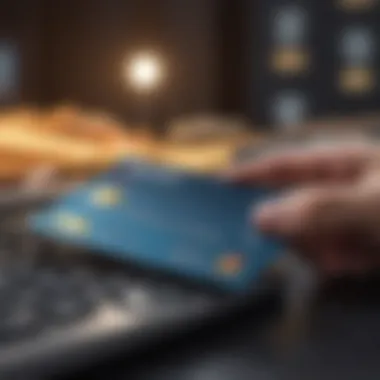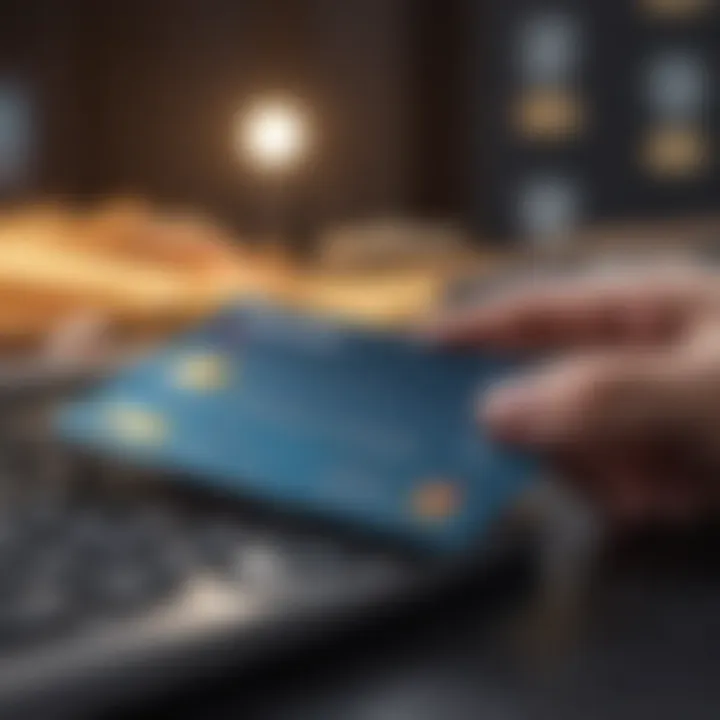Using a Bank Account for Secure Online Shopping


Intro
As the digital marketplace expands, the way we manage our finances evolves along with it. One significant change is the increasing reliance on bank accounts for online shopping. Understanding this process is crucial, as it encompasses a variety of factors including security, convenience, and efficiency. This guide aims to equip readers with knowledge about using a bank account for their online shopping needs, highlighting key considerations and strategies for safe transactions.
In this digital age, making purchases via bank accounts provides users both flexibility and a direct connection to their finances. Yet, alongside its benefits, there are risks and best practices that need careful attention.
Through this article, we shall explore critical insights into managing finances effectively while engaging in online shopping, addressing the advantages and pitfalls of using bank accounts for transactions.
Market Overview
Understanding the current landscape of online shopping is essential for consumers planning to make use of their bank accounts.
Current Market Sentiment
The sentiment surrounding online shopping is positive. More shoppers are comfortable with making purchases digitally, spurred on by advancements in payment technologies and wider acceptance of online payments. Consumers are increasingly viewing bank accounts as a safe means to handle their transactions.
Major Indices Performance
While this section typically refers to stock performance, the online retail market closely correlates with indices reflecting consumer spending habits. As people show increased spending in e-commerce, indicators like the Nasdaq composite often see upward momentum.
Economic Indicators Analysis
Several economic indicators impact online shopping behaviors, such as inflation rates, consumer confidence indices, and average wage growth. A solid understanding of these can guide consumers in their purchasing decisions, potentially influencing how they choose to finance their online shopping.
"The correlation between bank account usage and online shopping trends reflects a broader shift in consumer habits, emphasizing the need for informed financial decisions."
Advantages of Using a Bank Account for Online Shopping
Using a bank account for online purchases offers several advantages:
- Direct Access: Funds move directly from your account to the merchant, often ensuring instant payment.
- Enhanced Security: Transactions made through established bank accounts typically offer better security features compared to credit cards, reducing risks of fraud.
- Easier Budgeting: Monitoring online transactions directly from a bank account can facilitate better budgeting and financial management.
Potential Pitfalls
Despite the benefits, there are potential pitfalls to consider:
- Insufficient Funds: The risk of overspending can lead to account overdrafts, which can incur fees.
- Data Privacy Concerns: Sharing bank details online could expose consumers to identity theft if proper precautions aren’t taken.
- Limitations of Refunds: Unlike credit cards, bank account refunds may take longer to process, creating delays in receiving funds back.
Practical Steps for Secure Transactions
To ensure safe online shopping while using a bank account, consider the following:
- Use Trusted Websites: Always shop from reputable online stores that utilize secure payment processing.
- Enable Two-Factor Authentication: This adds an extra layer of security to online banking.
- Regularly Monitor Statements: Keeping an eye on bank statements can help quickly identify unauthorized transactions.
Closure
Using a bank account for online shopping is becoming more common. It presents both opportunities and challenges. However, with the right knowledge and practices, consumers can navigate the digital marketplace more confidently. This guide aims to illuminate the way forward, promoting informed decisions in financial management for all online shoppers.
Preface to Online Shopping
Online shopping has transformed the retail landscape significantly in recent years. With the growing popularity of e-commerce, understanding how to manage online transactions becomes crucial for consumers. Many people now prefer the convenience of purchasing goods and services from the comfort of their homes. This article explores the dynamic relationship between bank accounts and online shopping, providing insights into secure financial practices.
Today, a majority of consumers engage in various forms of online shopping, whether it is through personal computers, smartphones, or tablets. The accessibility of the internet and technological advancements have made it easier to compare prices, read reviews, and enjoy an array of products at one’s fingertips. Not only has this change influenced consumer behavior, it has also shaped the way businesses operate.
By using a bank account for online shopping, consumers can take advantage of direct transactions, which often leads to higher security levels. This form of payment can reduce transaction fees, compared to using credit cards or digital wallets, leading to cost savings for buyers. Additionally, certain bank accounts offer fraud protection, which provides further security while navigating the online marketplace.
As the digital economy evolves, so do the risks associated with online shopping. Therefore, it is critical to understand how to protect one’s financial information. Choosing the right bank account and learning effective strategies to maintain security helps mitigate these risks.
The Evolution of Shopping Behavior
The evolution of shopping behavior has become increasingly evident over the last few decades. The shift from brick-and-mortar stores to online platforms has altered the traditional shopping experience. Initially driven by convenience, online shopping now appeals to a desire for variety and accessibility.
- Convenience: More people are working long hours and balancing busy schedules. Online shopping allows them to make purchases any time of day without visiting a physical store.
- Comparison Shopping: Customers can easily compare products and prices across multiple retailers in mere minutes, allowing them to make informed decisions quickly.
- Informed Consumers: With vast information available online, today’s consumers often research and read reviews before committing to purchases, which affects their buying choices.
"The shift to online shopping has democratized access to products, allowing consumers greater choice than ever before."
This evolution has not only influenced consumer preferences but has also compelled retailers to adapt their strategies. Many have developed robust online presences to remain competitive and meet changing demands. As such, understanding the role of bank accounts in the online shopping ecosystem is vital for both consumers and businesses alike.
Understanding Bank Accounts
Bank accounts represent a fundamental aspect of personal finance management, especially when it comes to online shopping. They play a pivotal role in how individuals conduct transactions in the digital marketplace. Understanding bank accounts allows consumers to make informed choices on which accounts best suit their spending habits while ensuring safety and convenience.
A bank account provides a structured way to manage funds. This structure aids in tracking spending, creating budgets, and ultimately controlling financial health. Consumers engaging in online shopping benefit significantly from the capabilities and advantages that bank accounts offer. Moreover, being knowledgeable about the specific features of bank accounts can enhance the overall customer experience when purchasing goods and services online.
Types of Bank Accounts
Different types of bank accounts are tailored to meet varying needs. The most common categories include:
- Checking Accounts: These accounts allow for unrestricted access to deposits and withdrawals. They typically feature debit cards and checkbooks, making them highly functional for everyday transactions.
- Savings Accounts: Designed for storing money while earning interest, savings accounts encourage individuals to save for future needs. They usually have limited transaction capabilities compared to checking accounts.
- Money Market Accounts: These blend features of checking and savings accounts. They may offer higher interest rates but require a higher minimum balance.
- Certificates of Deposit (CDs): These accounts lock funds for a specified period in exchange for a higher interest rate.


Each type comes with distinct features and limitations. Choosing the right type of account depends on one's financial behavior and shopping preferences.
Choosing the Right Account for Online Purchases
Choosing an appropriate bank account for online purchases is crucial. Factors to consider include:
- Fees: Some accounts charge monthly maintenance fees or transaction fees. Be aware of these costs when selecting a bank account for online shopping.
- Withdrawal and Transfer Limits: Certain accounts may limit how much money one can withdraw or transfer. This can affect convenience during online transactions.
- Accessibility: Ensure that the account offers easy access to funds when shopping online. Many banks provide user-friendly online platforms and mobile apps to help consumers stay connected and manage their finances efficiently.
- Fees for International Transactions: If shopping globally, consider an account that minimizes international transaction fees.
When contemplating which bank account to utilize for digital transactions, it is also wise to evaluate the security features offered, such as fraud monitoring services or two-factor authentication.
Setting Up Your Bank Account for Online Shopping
Setting up your bank account for online shopping is a crucial step in ensuring a smooth and secure purchasing experience. This section discusses the various components involved and highlights the benefits associated with proper setup. Understanding these elements helps users utilize their bank accounts efficiently while shopping online.
First, it's essential to choose the right bank account that aligns with your online shopping habits. Factors such as transaction fees, interest rates, and accessibility to online services should be considered. A checking account with minimal fees is often recommended, as it offers easy access for daily spending without the drawbacks often seen with savings accounts.
Additionally, online banks may provide more favorable conditions than traditional institutions. They often have lower fees and better interest rates. However, it’s vital to ensure that the online bank you choose has a strong reputation and adequate security measures in place. Researching online reviews and gathering recommendations can guide your decision.
Moreover, setting up proper security features is paramount. Activation of bank alerts can notify you of suspicious activities. This is a preventative measure that allows you to quickly react to unauthorized transactions. Always ensure that your bank's online platform utilizes strong encryption methods to safeguard your information.
Linking Your Bank Account to Shopping Platforms
Linking your bank account to shopping platforms is an essential part of the setup process. This action allows for seamless transactions while maximizing benefits. Most online retailers provide a straightforward way to connect with your bank account, often requiring only a few pieces of information.
To link your account, you typically need your account number, routing number, and possibly your bank's online banking login details. Be diligent when entering this information, as accuracy is crucial. A small error can lead to failed transactions or, worse, compromise your personal data.
When you successfully link your bank account, it allows for direct payments without the need for intermediary methods. The benefits include:
- Lower fees: Direct transactions often incur fewer charges compared to using credit cards or digital wallets.
- Immediate transfers: Payments can be processed instantaneously, which is beneficial for both buyers and sellers.
- Better control over spending: By using funds directly from your bank account, you can manage your budget more effectively and avoid the pitfalls of overspending associated with credit cards.
"Linking your bank account directly can enhance your budgeting skills, making you a more responsible shopper."
Lastly, always verify your linked accounts periodically. Ensure that there are no unauthorized changes or connections to unfamiliar shopping platforms. Regular monitoring is an effective way to mitigate potential risks associated with online shopping.
Advantages of Using a Bank Account for Online Transactions
Using a bank account for online transactions comes with numerous advantages that cater to both convenience and security. These benefits are crucial for individuals looking to navigate the digital marketplace safely. Bank accounts facilitate a seamless shopping experience by connecting directly to various online platforms. This integration often leads to smoother transactions without additional steps, making purchases swift and more manageable. Additionally, using a bank account allows for greater financial oversight, which is important for managing spending habits.
Direct Banking Integrations
Direct bank integrations offer a streamlined process when making online purchases. Many e-commerce platforms like Amazon and eBay allow customers to link their bank accounts for quicker checkouts. This directly connects the customer's financial resources to their shopping preferences. Such integrations often enable users to bypass credit cards and electronic wallets. This reduces the number of steps needed to complete a purchase.
It can be beneficial during times when a credit card may not be available or when avoiding debt is a priority. Connecting directly to a bank account eliminates the potential of accumulating interest on purchases. Moreover, payments made directly from a bank account often settle immediately, reducing the lag time associated with other payment methods. This can be especially important for transactions that require prompt processing.
Security Features Compared to Other Payment Methods
When it comes to security, bank accounts can offer specific advantages. First, there is usually a higher level of security associated with direct bank payments than with debit or credit cards. Banks implement multi-factor authentication and encryption methods to protect users. Unlike credit cards which may incur unauthorized charges, bank transactions often require additional authentication after errors, further protecting consumers.
The risk of identity theft is also less with bank account transactions when proper precautions are taken. Users are required to be more vigilant about sharing their bank details, generally not needed for day-to-day purchases. This plays a significant role in cutting down fraud rates.
Always use secure networks when making transactions to minimize risks.
Risks and Precautions While Shopping Online
Online shopping has become a common practice in today’s digital world. However, it carries inherent risks that individuals must recognize to protect their finances. Understanding these risks and knowing how to mitigate them is essential for anyone using a bank account for online purchases. By being aware of potential dangers, shoppers can enjoy the conveniences of e-commerce without falling prey to scams or theft.
Identifying Suspicious Websites
When engaging in online shopping, the first step towards security involves identifying websites that may not be trustworthy. Suspicious websites often have certain characteristics that can alert consumers. These include:
- Poor Design and Functionality: Websites that are poorly designed with broken links or glaring grammatical errors can signal a lack of professionalism.
- Unusual Payment Options: If a website offers non-standard payment methods, it may be a red flag. Stick to recognized payment processors.
- Missing Contact Information: Legitimate websites typically provide clear contact details, including a physical address and customer support contact.
- Too-Good-To-Be-True Offers: If a deal seems extraordinarily low compared to market rates, it is worth investigating.
"Verify the URL: Always check for a secure connection, indicated by 'https://' in the web address."
Before making a purchase, take a moment to assess the website's credibility. Using tools like website reviews or rating systems can provide additional insights into the website's legitimacy. Requesting reviews from experienced users or researching on social media platforms can also help.
Managing Fraud Concerns
Fraud is a significant concern when shopping online. Protecting your data and finances requires vigilance and strategy. Here are a few practices to minimize your risk:
- Regular Monitoring of Bank Statements: Keep a close eye on bank transactions and credit card statements for any unfamiliar charges. Prompt reporting to your bank can prevent further issues.
- Utilization of Alerts: Set up transaction alerts through your bank. Alerts can notify you of large purchases or international charges that you may not have made.
- Two-Factor Authentication: When possible, enable two-factor authentication for your bank account. This adds an extra layer of security that can deter unauthorized access.
- Educate Yourself on Common Scams: Being aware of the latest scams can empower users to spot them before they engage. Stay informed through news articles and alerts from credible financial institutions.
Implementing these strategies can significantly reduce the likelihood of falling victim to online fraud. It's essential to approach online shopping with both enthusiasm and caution to foster a secure shopping experience.
Best Practices for Secure Online Transactions
Online shopping has transformed the way consumers interact with retail. As this shift occurs, maintaining security becomes critical. Following best practices can help mitigate risks and ensure safe transactions.
Utilizing Secure Networks


When making online purchases, one of the foundational aspects of security is the network you use. Public Wi-Fi networks can be tempting due to their accessibility, but they often lack essential security measures. It is advisable only to conduct transactions over a secure, private network. Using a virtual private network (VPN) can enhance security, shielding personal data from potential eavesdroppers.
Remember: Secure networks encrypt your data, making it significantly harder for attackers to intercept sensitive information.
To summarize the steps for utilizing secure networks:
- Avoid public Wi-Fi for financial transactions.
- Opt for VPNs when accessing banking and shopping sites away from home.
- Ensure the network is secure (look for WPA2 encryption).
Implementing Strong Password Practices
Passwords serve as the first line of defense against unauthorized access. It is vital to create complex and unique passwords for online banking and shopping accounts. Avoid using easily guessed information, such as birthdays or common phrases. Opt for combinations of letters, numbers, and symbols. Consider using a password manager to keep track of different passwords securely, reducing the risk of forgetting them or reusing them across multiple sites.
Strong password practices include:
- Creating complex passwords (at least 12 characters, with numbers and symbols).
- Changing passwords regularly to prevent unauthorized access.
- Using two-factor authentication (2FA) for an added security layer.
Managing Finances While Shopping Online
Managing finances while shopping online is essential in today's digital landscape. The convenience of online shopping can lead to unplanned spending and financial strain without a well-structured approach. This section emphasizes the critical aspects of financial management tailored for online transactions.
Importance of Financial Management
When using a bank account for online purchases, understanding one's financial limits becomes imperative. Online platforms often present endless choices and sales. This can lead to impulse buying and overspending. Therefore, setting clear budgets helps individuals make informed decisions and minimize financial risks.
Benefits of Managing Finances
- Avoiding Debt: Sticking to a budget prevents overspending, reducing the likelihood of accumulating credit card debt.
- Enhanced Control: A structured financial plan gives users better control over their expenses, allowing them to prioritize essential purchases.
- Informed Decisions: Knowing your financial situation helps in making purchases that align with your financial goals.
Considerations
It’s vital to keep in mind that financial management while shopping online extends beyond just setting a budget.
- Regularly reviewing bank account statements can help track spending habits.
- Being aware of recurring payments can help avoid unwanted financial commitments.
Setting Budgets and Sticking to Them
Setting a budget is fundamental to good financial management, especially while shopping online. A budget acts as a guideline for what you can afford, helping you avoid unnecessary expenditures. Here are a few critical steps to establish and maintain a budget:
- Evaluate Monthly Income: Knowing your total income will provide a clearer picture of how much you can allocate toward shopping.
- Identify Needs vs. Wants: Distinguish between essential items and luxury purchases. This clarity will aid in prioritizing spending.
- Set Spending Limits: Decide on a specific amount for online shopping. This limit should be realistic based on your financial situation.
- Use Bank Tools: Many banks offer budgeting tools that categorize spending and provide alerts when nearing set limits.
Implementing these steps increases accountability and provides motivation to stick to the budget.
Quote: "An effective budget is not just a plan; it’s a pathway to financial freedom."
The Role of Technology in Online Shopping
Technology plays a pivotal role in shaping the landscape of online shopping. The integration of various technological advancements has transformed how consumers interact with businesses and make purchases. As consumers increasingly rely on digital platforms for shopping, understanding the influence of technology becomes essential for making informed decisions regarding transactions. This section will explore specific elements of technology at play in online shopping and their implications for consumers and businesses alike.
Emerging Technologies in Financial Transactions
Recent years have witnessed rapid advancements in the technology behind financial transactions. Emerging technologies have not only enhanced the efficiency of online shopping but have also redefined the security and convenience associated with bank account usage.
- Mobile Payment Solutions: Mobile wallets like PayPal, Apple Pay, and Google Pay have gained popularity, enabling seamless transactions directly from mobile devices. These platforms often link directly to users' bank accounts, allowing for quick payment options without the need for physical cards.
- Blockchain Technology: Blockchain is increasingly being employed to enhance security in financial transactions. This decentralized ledger technology ensures transparency and integrity of transactions, reducing the risks associated with fraud.
- Artificial Intelligence: AI is playing an important role in enhancing the user experience in online shopping. From personalized recommendations to fraud detection systems, AI algorithms analyze consumer behavior to streamline the shopping process and protect against potential threats.
- Encrypted Transactions: Innovations in encryption technology enhance the safety of online transactions. HTTPS protocols ensure that data shared during a transaction is encrypted, making it more difficult for malicious actors to intercept sensitive information.
- Biometric Authentication: More digital banking platforms are incorporating biometric security measures, such as fingerprint scanners and facial recognition, to verify identity before allowing transactions. This elevates the level of security and builds trust in online shopping.
The impact of these technologies on online shopping is profound. While these advancements bring about numerous benefits, they also present considerations that users must be aware of. Consumers should stay informed about the technologies they utilize to ensure their online shopping experiences are secure and reliable.
"Technology, when used wisely, can greatly enhance the security and convenience of online transactions, ensuring more satisfied consumers in the digital marketplace."
In summary, the role of technology in online shopping is multifaceted. It not only facilitates transactions but also safeguards against vulnerabilities in the online environment. As the landscape continues to evolve, consumers and businesses must adapt to these changes to take full advantage of the efficiencies that technology offers in financial transactions.
Comparing Bank Account Payments with Other Methods
When navigating the landscape of online shopping, understanding the various payment methods is essential. Comparing bank account payments with other methods provides insights into the advantages, limitations, and practical applications of each option available to consumers. Given the rise of e-commerce, there is a pressing need to evaluate how bank accounts can fit into one’s overall payment strategy. This section sheds light on key differences among payment forms, emphasizing the unique position bank accounts hold in the digital marketplace.
Credit and Debit Cards
Credit and debit cards continue to dominate online payment landscapes. With their widespread acceptance, they offer convenience and reward programs. However, there are some notable considerations in using credit and debit cards compared to bank accounts.
- Credit Usage: Credit cards allow users to borrow money up to a certain limit, enabling purchases beyond immediate cash availability. This can aid budgeting but may lead to overspending if not managed properly.
- Instant Availability: Debit cards rely on funds available in the linked bank account. This can foster a sense of controlled spending but offers less flexibility compared to credit cards.
- Security Features: Many credit card companies provide fraud protection that can sometimes supersede what bank accounts offer. However, consumers still face risks if proper precautions are not taken.
When choosing between a bank account and credit or debit cards, users should weigh the balance of risk and reward according to personal financial habits. Each method carries benefits and potential drawbacks that can significantly impact one's online purchasing experience.
Digital Payment Solutions
Digital payment solutions such as PayPal, Venmo, and Apple Pay have gained immense popularity. These options provide quick and often user-friendly interfaces for transactions. An important comparison arises when evaluating these solutions against traditional bank account payments.
- Speed and Convenience: Digital payment platforms often facilitate faster transactions. Funds can move quickly between users, which is a significant advantage for impulse buys or time-sensitive transactions.
- Fees: Some platforms charge fees for transactions linked to a bank account or credit card. It's crucial to review terms carefully to avoid unexpected costs.
- Enhanced Security: Many digital platforms offer advanced security features, including two-factor authentication, which can provide a sense of security. However, these services also depend on the underlying bank account security.
Ultimately, whether a user chooses digital payment solutions, bank accounts, or a mixture of methods requires an understanding of personal habits. Each platform offers distinct elements that can either enhance or complicate the online shopping experience. The path forward lies in informed decision-making.
Evaluating the Future of Online Shopping
Trends Shaping Online Payment Methods


The landscape of online shopping is rapidly changing, influenced by various factors that include technological advancements and shifting consumer preferences. Evaluating the future of online shopping is essential for understanding how these dynamics affect consumer behavior and the evolution of payment methods. As more individuals turn to digital marketplaces for their shopping needs, it becomes critical to assess which trends are emerging and how they will shape the economy.
One of the most prominent trends is the rise of mobile payments. Consumers are increasingly using their smartphones to complete purchases, influenced by the convenience and speed of mobile applications. Platforms such as Apple Pay and Google Pay have streamlined the process, allowing users to transact effortlessly with just a few taps. Given this shift, retailers must prioritize compatibility with these mobile payment solutions to attract customers.
Another significant trend is the increasing emphasis on security. With online fraud at an all-time high, consumers are more cautious about their payment methods. Businesses that implement advanced security features, such as two-factor authentication and end-to-end encryption, are more likely to gain consumer trust. This trust is a key element for success in the online shopping market, where ensuring a safe transaction environment can differentiate a business from its competitors.
The involvement of cryptocurrencies in online transactions is another emerging trend. As digital currencies gain popularity,** platforms like Bitcoin become viable payment methods for an increasing number of merchants**. This diversification allows consumers to use their preferred currency, catering to a wider audience. However, volatility still poses a challenge in this area, making it essential for companies to weigh the pros and cons of accepting cryptocurrencies.
Lastly, the integration of artificial intelligence in online payment systems cannot be overlooked. AI is being harnessed to analyze consumer behavior and streamline personalization in shopping experiences. Consumers benefit from tailored recommendations and targeted promotions, which create a more engaging shopping environment.
In summary, the trends shaping online payment methods point toward a future that is increasingly mobile, secure, diverse in currency options, and enhanced by technology. Adapting to these changes is necessary for any individual or business seeking to maintain relevance and succeed in the evolving landscape of online shopping.
Case Studies of Bank Account Usage
Understanding how individuals utilize bank accounts in online shopping is crucial for several reasons. Firstly, case studies provide practical examples that highlight the effectiveness and challenges associated with using a bank account for transactions. These real-life scenarios can help potential users understand the environment in which online banking operates. Observing patterns of consumer behavior through these case studies can also reveal significant insights about how various demographic groups approach online purchases.
Furthermore, analyzing consumer experiences with their bank accounts gives depth to statistical data regarding online shopping. These narratives can inform financial institutions, helping them design better products that cater to users' needs. As online shopping continues to grow, so does the importance of adapting banking practices and enhancing their security features to accommodate user demands.
In summary, case studies serve as a bridge between theoretical discussions about bank account usage and practical, real-world efficiencies or inefficiencies. They also underline the need for better financial literacy among consumers, which can empower them to make informed decisions regarding their transactions.
Consumer Experiences
Consumer experiences provide an authentic perspective on the relationship between bank accounts and online shopping. By dissecting different user stories, we can observe how personal interactions with banking services influence shopping behaviors. Many individuals express a preference for using their bank accounts over credit cards due to perceived security advantages and a desire to avoid debt.
Some consumers report that having a dedicated online banking application can streamline their shopping process. They appreciate the ability to access their finances instantly, which helps them make quicker purchasing decisions. Other users have mentioned frustrations with bank account linking processes. These challenges sometimes result from complicated verification procedures or slow processing times for transactions, which can deter consumers from using their bank accounts as a preferred payment method.
Grounded in these experiences, we can identify key themes that impact user satisfaction:
- Security: Many users prioritize security features, benefiting from the trustworthiness of their banks.
- Convenience: The ability to easily link accounts to shopping platforms can enhance user experience.
- Customer Service: Responsive help from banking institutions can significantly affect customer loyalty.
These consumer experiences not only illustrate the complexities of online shopping but also highlight the areas where banking institutions can improve. By learning from user stories, banks can adapt their services to better meet the needs of online shoppers, fostering a more competitive environment in the digital marketplace.
Bank accounts, when used effectively, can transform the online shopping experience into a secure and efficient process.
Legal Considerations in Online Banking
Understanding the legal landscape surrounding online banking is vital for anyone using their bank account for online shopping. Legal considerations encompass a variety of topics, including consumer rights and privacy regulations, each playing a significant role in ensuring a safe online shopping experience. Being aware of these laws not only aids in protecting consumers but also enhances the overall trust in online transactions.
Consumer rights form the backbone of legal considerations in online banking. These rights are designed to protect users from unfair practices and fraud. Consumers should know that they are entitled to receive accurate information about products and services, including prices and terms of service. Additionally, they have the right to dispute unauthorized transactions. Banks usually provide a dedicated support system to address such disputes, giving consumers the power to safeguard their interests.
In many regions, laws such as the Electronic Fund Transfer Act in the United States ensure that consumers are entitled to prompt investigations of unauthorized transactions. Understanding these rights is crucial, as ignorance can lead to losses that might otherwise have been preventable.
"The protection of consumer rights is not just a legal obligation for banks; it is essential for building trust and promoting responsible financial behavior among customers."
Next, privacy regulations are equally important in this context. With the rise of digital banking, safeguarding personal information has become more critical than ever. Various laws, such as the General Data Protection Regulation (GDPR) in Europe and the California Consumer Privacy Act (CCPA) in the United States, set clear rules about how companies, including banks, can collect, use, and share customer data.
These regulations compel financial institutions to offer transparency about their data handling processes. They must inform users about the data being collected and the reasons for this collection. This understanding empowers consumers to make informed choices regarding the use of their bank accounts for online shopping.
Furthermore, privacy regulations often require banks to implement robust security measures to protect consumer information from breaches. This can include encryption, secure login protocols, and monitoring for suspicious activity. Failures in these areas can lead to legal ramifications and loss of consumer trust. Hence, users should feel confident that their personal data is handled according to legal standards, enhancing their online shopping experience.
In summary, the legal considerations in online banking are critical for creating a safe environment for consumers. Understanding one's rights and the relevant privacy regulations establishes a framework for secure online transactions. As more individuals turn to online shopping, awareness of these legal aspects becomes increasingly important for both consumers and financial institutions.
Resources for Further Learning
Learning does not stop at understanding the process of using a bank account for online shopping. Resources for further learning are vital. They help individuals enhance their knowledge and skills regarding online finance. In an ever-evolving digital marketplace, financial literacy enables better decision-making. Here are some key reasons why these resources are important:
- Empowerment: Having access to a range of financial literacy programs can empower consumers. When people understand how to manage their money, they make informed decisions in online shopping.
- Risk Mitigation: Many consumers may face risks online, including fraud. Learning how to recognize these risks can help mitigate potential losses. Resources can provide valuable insights into protective measures.
- Staying Up-to-Date: The financial landscape changes. New technologies and regulations emerge regularly. Engaging with learning resources ensures you stay current with industry trends and changes.
Incorporating these insights into personal finance habits can lead to a better experience in online shopping.
Financial literacy programs
Financial literacy programs offer structured learning opportunities. They cover essential topics that are especially relevant for online shopping. Many organizations provide programs, often for free or at a low cost. Key areas they address include:
- Budgeting Basics: Programs often teach simple budgeting skills. Knowing how to allocate funds appropriately can prevent overspending during online shopping.
- Understanding Transactions: Learning the mechanics of transactions can be useful. Participants gain clarity on how money moves when purchases are made online.
- Credit Management: These resources can explain how credit scores work. Understanding this helps consumers avoid pitfalls related to credit cards and financing.
Engagement in such programs can lead to practical life skills. Individuals become more competent in using their bank accounts for online purchases. As a result, they experience not just financial savings but also peace of mind.
For additional knowledge, consider exploring reputable sources on financial literacy. Websites like Britannica or platforms such as Reddit may offer targeted discussions or articles that enhance understanding.
"Knowledge is power, especially in finance. Building literacy is crucial for navigating online shopping successfully."
Taking advantage of resources available in your community or online can be transformative. Informed consumers are more likely to make prudent choices in digital marketplaces. Therefore, diving into financial literacy programs is not just an option but a necessity for sustainable online shopping behavior.
Ending
In today's digital economy, using a bank account for online shopping is a critical subject that merits comprehensive understanding. The significance of this topic is rooted in several factors that intertwine the convenience of online transactions with financial security and budgeting discipline.
Summary of Key Points
The following key points summarize the core elements discussed in this article:
- Convenience and Efficiency: Linking a bank account to online shopping platforms streamlines the payment process, allowing for faster transactions without the need for physical cards.
- Security Features: Bank accounts often provide robust security measures, such as two-factor authentication and transaction alerts, that protect consumers from fraud.
- Cost-Effectiveness: Using a bank account can limit additional fees associated with credit and debit card transactions. Often, it leads to better budgeting practices, as consumers directly see their cash flow.
- Risk Awareness: Understanding the dangers of online shopping is paramount. Identifying suspicious websites and managing fraud concerns ensures a safer shopping experience.
- Legal and Regulatory Considerations: Consumers should be aware of their rights and privacy regulations, allowing them to navigate the online marketplace confidently and securely.
These points encapsulate the multifaceted nature of this topic, emphasizing the necessity for both beginners and seasoned shoppers to approach online shopping with knowledge and prudence. As e-commerce continues to grow, having a clear understanding of how to effectively use bank accounts for transactions can significantly enhance one's online shopping experience.



